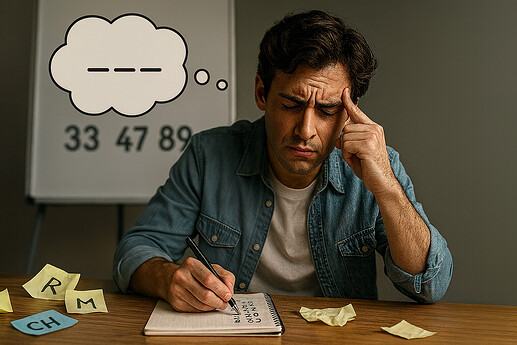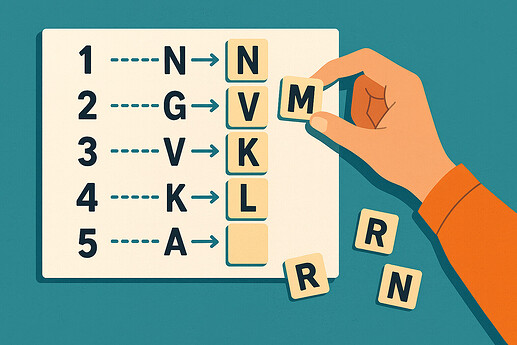You have so many options when you’re creating a number system. For a single digit system, you can have:
- Number rhyme system
- Number shape system
If you want to get more advance, you can create a 2 digit number system using:
- The Dominic System
- the Ben System
- Other variations of these systems
But the one system that sits beneath most of these number systems: the Major System.
You can see a full 2 digit Major System here: Major System Full List Example (2 Digit System)
You can create your images with this free tool: Create a Major Number System
Major Number System
The Major System is simple and straightforward for creating images from numbers. It’s based on sounds (phonetics) of the letters in the system. Below is the standard Major System.
The Standard Major System (0–9)
0 = S, Z, soft C
1 = T, D
2 = N
3 = M
4 = R
5 = L
6 = J, SH, CH, soft G
7 = K, hard C, hard G, Q
8 = F, V, PH
9 = P, B
Vowels (A, E, I, O, U) and the letters H, W, Y are usually ignored. Silent letters are ignored. Focus on the phonetic consonant sounds.
What I mean by sound-based is this: take 0. It’s represented by the S/Z sound (think “zero,” “z,” or the hiss of “s”). That idea repeats for every digit: each number = a consonant sound group.
You build words by adding vowels around those consonants. The order the digits appear in the number is how the sounds need appear in the word.
1 Digit Number System
The Major System can work as a single-digit system. Just pick a word that starts with the target digit’s sound.
Example: for 3 (M), you could use Mike, Mickey, or Mouse since these words start with the M sound.
You would do the same thing for the rest of the digits 0 - 9. When you use your image and see it in your mind like Mouse, you know Mouse has the M sound and 3 has the M sound so Mouse represents 3.
Since you only have 10 images to remember, I highly recommend just having these images set in stone. So every time you see a 3, you think of Mouse. These images will never change. Now a 2 digit number system is a bit different when it comes to having the same images with the Major System.
2 Digit Major Number System
To make a two-digit system (00–99), line up the sounds in order.
Example of what doesn’t count for 00: “socks.” It starts with S (0) but the next consonant sound is K (7), so that’s 07 and not 00, even though it ends with an “s.”
The order of the consonant sounds in the word must match the order of the digits.
Concrete example for 00: “sauce.”
You can see the first sound you have is an S so it would be 0 and the next sound is also an S sound. You end up phonetically: S … S → 0-0.
A flexible twist (first/last or first/second emphasis)
I like having freedom in how I build images. You are limited to having the first two sounds of a word represent the number pairing. You can use the first sound and last sound of the word, first sound and third sound, or any combination.
For example:
“socks” could be 00 in a first/last-sound variant (starts with S, ends with S).
“leopard” could be 51 in a first/last variant (L = 5, …D = 1), instead of 59 if you followed standard internal sequencing.
Why the Major System is so handy
One huge advantage is you don’t need pre-made images like a traditional 2 digit pr 1 digit number system. You can create your images on the spot.
You see the number 33 → M-M → “MoM”. Even without a prebuilt list, you can decode it back to 33 by sound.
Cons of the Major System
If you don’t have any premade images for the major system, then the main issue you run into is consistency in your images and slow speed.
When it comes to creating images, you can have images that can be called different things. A backpack (97) can be called rucksack (47), bookbag (97) , knapsack (29), or bag (96). As you can tell, all of those words would represent different numbers.
The issue you face is that in your mind you see a backpack, but you might remember what word you used to create the image of the backpack. If you pick the wrong word, then you will recall the wrong number. This is the danger of not having a consistent image for numbers.
Another issue you face is a speed issue when it comes to actually memorizing a number. If you create your word on the spot, it is going to take time to figure out what word will fit the code.
Maybe some days you can create the word more quickly, but other days you struggle to find a word that fits. The thing is you can’t memorize the number until you have a word/image so you will need to stay stuck for however long you it takes you to figure it out.
With premade images, you already know what you will picture so you don’t face the same struggle of coming up with an image on the spot. The good news is you can always create premade images with the Major System for a 2 digit number system. You will just create images based off the letter sounds and have the images set to the pairing of the numbers.
One last issue deals with trying to create words with numbers that have more than 2 digits. If you try to encode 3–4+ digits into a single word, the word must contain all those sounds in exact order.
That gets hard fast. You’ll spend more time searching for the “perfect” word and increase the risk of decoding errors. Right now try to create a word for 2598. Really try to create a word. I have no idea on where to start! haha
The easy solution to this is that you just take 2 digits at a time. If you feel adventurous, you can even do 3 digits at a time. The way you would store the numbers also will have prevent this issue.
Customize the Major System
There’s a reason for the standard associations (e.g., 2 looks like N, 3 looks like M, 0 hisses like S/Z), which makes them easy to remember. But you’re not forced to keep the defaults. You could have something like this for the sounds:
0 = Z
1 = L
2 = N
3 = W
4 = R
5 = V
6 = J
7 = K
8 = F
9 = N
If changing a digit’s letter set gives you more image options and faster recall, do it. The only non-negotiable is consistency: you must translate sound ↔ digit. Use what makes sense to you and allows you to create the best images!
Training the base reflex
There is one part of the Major System you need to get down and that is the connection between the digit and sound.
Digit → sound → digit.
Once that’s automatic, you can create images more quickly and translate your images back into the numbers by breaking the sounds in the word down. This can take a bit to learn if your numbers each have multiple sounds they can make.
How to memorize numbers with the Major System
Story method:
Break the number how you want (2 digits, 3 digits, etc.), make a word/image for each chunk, and link them in a story. Say this is your number: 334789
Example (pairs):
33 → “mom” (M-M)
47 → “rock” (R-K)
49 → “robot” (R-B)
Now connect them in a story: “My mom is throwing a rock at a window and a robot comes out screaming at her” and so on.
To recall, decode each image back by its sounds in sequence. Then move to the next main image in the story.
If you use a personal variant like “first/last sound,” that’s fine just know that standard Major would also count all consonant sounds in order (e.g., “robot” would normally be R-B-T → 4-9-1, not just 49).
But if you know you are only memorize 2 digits at a time, Robot could work for 49 since the T in the robot has no value to you in this case.
Memory palace (story + locations)
You are using the same idea as the story method, but you place each mini-story at a fixed location (driveway, flower bed, front door, etc.) to lock in order and reduce drift.
My first location might be the driveway so I would image the story from the story method happening in my driveway: My mom is throwing a rock at the garage door and a robot comes out screaming at her.
So in one location I took 6 digits at a time. I would move to the next location in my palace and picture the next story from the 6 digits and so on.
Final Thoughts
That’s the Major System: how to build it, how to use it, the benefits (flexibility, accuracy) and the downsides (speed/consistency if you improvise, difficulty packing too many digits into one word).
The Major System is a very useful system that is not only restricted to numbers but can be applied to sort of material. You can use the Major System for cards. You would have each suit of the card and value of the cards have specific sounds they can be. Then when you combine the suit and value, you know the sounds the word has to have .
One important thing to remember is there is not a singular best system. The Major System is just one one tool among many systems and methods. You should definitely keep it in your back pocket!
Do you use the Major System? Is there anything I missed about the major system?





